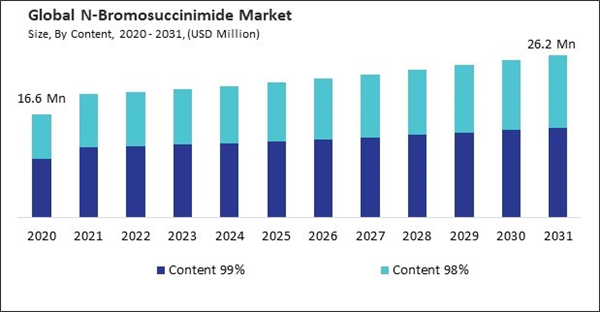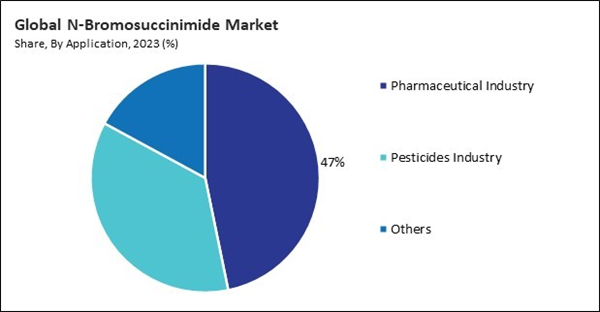The North American region is at the forefront of advancements in chemical synthesis technologies, including bromination reactions facilitated by NBS. Thus, the North American region would acquire nearly 25% of the total market share by 2031. Also, the US market would consume 79.31 tonnes of this chemical by 2031. Researchers and chemists in academia, government institutions, and private companies are constantly exploring new synthetic methodologies and innovative applications of NBS in organic synthesis. This drive for innovation and efficiency contributes to the increasing demand for NBS in North America.
Chemical synthesis encompasses a broad range of reactions and transformations aimed at producing desired organic molecules and compounds. NBS finds applications in numerous synthetic methodologies, including halogenation, oxidation, substitution, and cyclization reactions. Moreover, chemical synthesis is instrumental in the development of advanced materials such as polymers, nanomaterials, and organic semiconductors with tailored properties and functionalities. NBS facilitates the modification of material surfaces, incorporation of bromine functionalities, and synthesis of brominated polymers with enhanced properties. In conclusion, expansion of chemical synthesis is driving the growth of the market. Additionally, Lithium-ion batteries are widely used in various applications, including electric vehicles (EVs), renewable energy storage systems, and consumer electronics, due to their high energy density, long cycle life, and environmental friendliness. NBS is employed in the synthesis of electrolyte materials, such as lithium bromide derivatives, which are crucial components of lithium-ion battery electrolytes. NBS-derived electrolyte additives offer opportunities for battery manufacturers to enhance battery performance parameters such as energy density, power output, and thermal stability. Thus, rising demand from the energy storage sector is propelling the growth of the market.
However, Bromine, a key raw material for the production of NBS, is primarily obtained as a byproduct of natural gas extraction or brine wells. The availability of bromine is thus inherently tied to the production of natural gas and the presence of brine deposits. Any fluctuations or limitations in natural gas extraction or brine well operations directly affect the availability of bromine, consequently impacting the production of NBS. Also, bromine is utilized in various industries beyond chemical synthesis, including flame retardants, oil and gas drilling fluids, and water treatment chemicals. The competition for bromine supply from these industries can further constrain its availability for NBS production. In conclusion, limited availability of bromine reserves are hampering the growth of the market.
Driving and Restraining Factors
Drivers- Expansion of chemical synthesis
- Rising demand from energy storage sector
- Increasing pharmaceutical industry worldwide
- Limited availability of bromine reserves
- Complexity in synthesis process
- Expansion in agrochemical applications
- Ongoing advancements in materials science
- Handling challenges and storage requirements
- Increasing competition from alternatives
Application Outlook
On the basis of application, the market is segmented into pharmaceutical industry, pesticides industry, and others. In 2023, the pesticides industry segment attained a 36% revenue share in the N-bromosuccinimide market. In terms of volume, the pesticides industry segment consumed 136.64 tonnes of this chemical in 2023. NBS is utilized in the synthesis of various pesticide intermediates and active ingredients through bromination reactions. Brominated compounds often exhibit desirable properties such as increased biological activity, enhanced stability, and improved efficacy against target pests.Content Outlook
Based on content, the market is divided into content 99 and content 98. In 2023, the content 98 segment acquired a 43% revenue share in the N-bromosuccinimide market. In terms of volume, the content 98 segment would register a volume of 167.14 tonnes in 2023. NBS is widely used as a brominating agent in organic synthesis reactions to introduce bromine atoms into organic molecules. High-purity NBS with a content of 98% or higher is preferred for complex synthesis reactions, pharmaceutical intermediates, and fine chemical manufacturing, where precise control over reaction conditions and product purity is essential.Regional Outlook
Region-wise, the market is analyzed across North America, Europe, Asia Pacific, and LAMEA. The Asia Pacific region witnessed 45% revenue share in the N-bromosuccinimide market in 2023. The Asia Pacific region is experiencing rapid industrialization and economic growth, leading to the expansion of industries such as pharmaceuticals, agrochemicals, and specialty chemicals. These industries are significant consumers of NBS, primarily due to its applications in drug synthesis, pesticide manufacturing, and chemical synthesis.List of Key Companies Profiled
- Nanjing Suru Chemical Co., Ltd.
- SAMUH LAXMI CHEMICALS (BOM) P. LTD. (Anron Chemicals Co. Group)
- Purecha Group
- Jiangxi Dasuo Chemical Co., Ltd.
- Resins and Allied Products
- Zhejiang Kente Catalysts Technologies Co., Ltd.
- HALIDES CHEMICALS PVT. LTD.
- Mody Chemi-Pharma Limited
Market Report Segmentation
By Content (Volume, Tonnes, USD Million, 2020-31)- Content 99%
- Content 98%
- Pharmaceutical Industry
- Pesticides Industry
- Others
- North America
- US
- Canada
- Mexico
- Rest of North America
- Europe
- Germany
- UK
- France
- Russia
- Spain
- Italy
- Rest of Europe
- Asia Pacific
- China
- Japan
- India
- South Korea
- Australia
- Malaysia
- Rest of Asia Pacific
- LAMEA
- Brazil
- Argentina
- UAE
- Saudi Arabia
- South Africa
- Nigeria
- Rest of LAMEA
Table of Contents
Companies Mentioned
- Nanjing Suru Chemical Co., Ltd.
- SAMUH LAXMI CHEMICALS (BOM) P. LTD. (Anron Chemicals Co. Group)
- Purecha Group
- Jiangxi Dasuo Chemical Co., Ltd.
- Resins and Allied Products
- Zhejiang Kente Catalysts Technologies Co., Ltd.
- HALIDES CHEMICALS PVT. LTD.
- Mody Chemi-Pharma Limited










